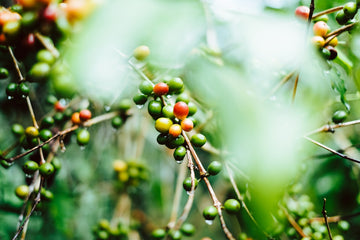An Overview of Coffee Processing Methods
Natural and wet processing are two predominant methods used for removing the outer fruit layers of coffee cherries to extract the beans, and each has a distinct impact on the coffee's ultimate flavor profile. Natural processing, also known as dry processing, involves drying the whole cherry in the sun. It is the world's oldest coffee processing method. After harvesting, cherries are typically spread out on large surfaces to dry naturally. During this time, the sugars and flavors from the cherry's pulp are absorbed by the beans, often resulting in a coffee that exhibits a fruitier, sweeter, and more robust flavor profile. This technique, however, demands a consistent, dry climate to prevent spoilage, and it requires meticulous attention to prevent over-fermentation or uneven drying.
Wet processing, by contrast, is a method where the fruit is removed from the beans before they are dried. This is typically achieved by pulping the cherries to separate the skin and pulp from the beans soon after harvesting, followed by fermenting the remaining mucilage in water tanks to break it down. The coffee beans are then washed and dried. This approach tends to produce a much cleaner and more consistent cup, with brighter acidity and a more refined flavor profile. The clarity and distinctiveness of flavors that wet processing facilitates are prized in specialty coffee, although the method requires significant water resources and infrastructure.
Both processing methods are vital in shaping the coffee's character, with natural processing celebrating the bean's inherent sweetness and body, while wet processing tends to enhance sophistication and clarity. Coffee aficionados appreciate these differences, seeking out beans processed in their preferred style for a desired coffee experience. Furthermore, environmental conditions and resources can influence a region's preferred processing method, thereby affecting the global diversity of coffee flavors.
It is, however, important to note that these are not the only methods used to process coffee. Other methods, such as honey processing, exist and offer a spectrum of flavors between the dry and wet extremes. Honey processing involves removing the skin of the coffee cherry but leaving some or all of the mucilage (the 'honey') before drying, leading to a cup that can have some of the fruitiness of natural-processed coffees along with the cleaner profile of washed coffees. Moreover, many producers are also experimenting with various fermentation techniques to develop unique profiles, adding even greater diversity to coffee flavors.
Wet processing, by contrast, is a method where the fruit is removed from the beans before they are dried. This is typically achieved by pulping the cherries to separate the skin and pulp from the beans soon after harvesting, followed by fermenting the remaining mucilage in water tanks to break it down. The coffee beans are then washed and dried. This approach tends to produce a much cleaner and more consistent cup, with brighter acidity and a more refined flavor profile. The clarity and distinctiveness of flavors that wet processing facilitates are prized in specialty coffee, although the method requires significant water resources and infrastructure.
Both processing methods are vital in shaping the coffee's character, with natural processing celebrating the bean's inherent sweetness and body, while wet processing tends to enhance sophistication and clarity. Coffee aficionados appreciate these differences, seeking out beans processed in their preferred style for a desired coffee experience. Furthermore, environmental conditions and resources can influence a region's preferred processing method, thereby affecting the global diversity of coffee flavors.
It is, however, important to note that these are not the only methods used to process coffee. Other methods, such as honey processing, exist and offer a spectrum of flavors between the dry and wet extremes. Honey processing involves removing the skin of the coffee cherry but leaving some or all of the mucilage (the 'honey') before drying, leading to a cup that can have some of the fruitiness of natural-processed coffees along with the cleaner profile of washed coffees. Moreover, many producers are also experimenting with various fermentation techniques to develop unique profiles, adding even greater diversity to coffee flavors.



